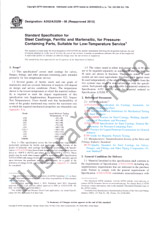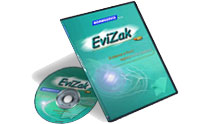Potřebujeme váš souhlas k využití jednotlivých dat, aby se vám mimo jiné mohly ukazovat informace týkající se vašich zájmů. Souhlas udělíte kliknutím na tlačítko „OK“.
ASTM D5961/D5961M-17
Standard Test Method for Bearing Response of Polymer Matrix Composite Laminates
Přeložit název
NORMA vydána dne 1.8.2017
Informace o normě:
Označení normy: ASTM D5961/D5961M-17
Poznámka: NEPLATNÁ
Datum vydání normy: 1.8.2017
Kód zboží: NS-693804
Počet stran: 31
Přibližná hmotnost: 93 g (0.21 liber)
Země: Americká technická norma
Kategorie: Technické normy ASTM
Kategorie - podobné normy:
Anotace textu normy ASTM D5961/D5961M-17 :
Keywords:
bearing properties, bearing strength, composite materials,, ICS Number Code 83.120 (Reinforced plastics)
Doplňující informace
| Significance and Use | ||||||||||||||||||||||||||||||||||||||||||||||
|
5.1 This test method is designed to produce bearing response data for material specifications, research and development, quality assurance, and structural design and analysis. The standard configuration for each procedure is very specific and is intended primarily for development of quantitative double- and single-shear bearing response data for material comparison and structural design. Procedures A and D, the double-shear configurations, with a single fastener loaded in shear and reacted by laminate tension or compression, are particularly recommended for basic material evaluation and comparison. Procedures B and C, the single-shear, single- or double-fastener configurations are more useful in evaluation of specific joint configurations, including fastener failure modes. The Procedure B specimen may be tested in either an unstabilized (no support fixture) or stabilized configuration. The unstabilized configuration is intended for tensile loading and the stabilized configuration is intended for compressive loading (although tensile loading is permitted). The Procedure C specimen is particularly well-suited for development of countersunk-fastener bearing strength data where a near-double-shear fastener rotational stiffness is desired. These Procedure B and C configurations have been extensively used in the development of design allowables data. 5.2 It is important to note that these four procedures, using the standard test configurations, will generally result in bearing strength mean values that are not of the same statistical population, and thus not in any way a “basic material property.” Note 2: Typically, Procedure D will yield slightly higher
strengths than Procedure A (due to the finite edge distance,
5.3 It is also important to note that the
parameter variations of the four procedures (tabulated in Section
4) provide flexibility in the
conduct of the test, allowing adaptation of the test setup to a
specific application. However, the flexibility of test parameters
allowed by these variations makes meaningful comparison between
datasets difficult if the datasets were not tested using the same
procedure and identical test parameters.
5.4 General factors that influence the mechanical response of composite laminates and should therefore be reported include the following: material, methods of material preparation and lay-up, specimen stacking sequence, specimen preparation, specimen conditioning, environment of testing, specimen alignment and gripping, speed of testing, time at temperature, void content, and volume percent reinforcement. 5.5 Specific factors that influence the bearing response of composite laminates and should therefore be reported include not only the loading method (either Procedure A, B, or C) but the following: (for all procedures) edge distance ratio, width to diameter ratio, diameter to thickness ratio, fastener type, fastener shear strength, fastener torque, fastener or pin material, fastener or pin clearance, tensile or compressive loading, countersink angle and depth of countersink, type of grommet (if used), type of mating material, number of fasteners, and type of support fixture (if used). Properties, in the test direction, which may be obtained from this test method include the following: 5.5.1 Ultimate bearing strength, 5.5.2 Offset bearing strength, 5.5.3 Bearing stress/bearing strain curve. |
||||||||||||||||||||||||||||||||||||||||||||||
| 1. Scope | ||||||||||||||||||||||||||||||||||||||||||||||
|
1.1 This test method covers the bearing response of pinned or fastened joints using multi-directional polymer matrix composite laminates reinforced by high-modulus fibers by double-shear tensile loading (Procedure A), single-shear tensile or compressive loading of a two-piece specimen (Procedure B), single-shear tensile loading of a one-piece specimen (Procedure C), or double-shear compressive loading (Procedure D). Standard specimen configurations using fixed values of test parameters are described for each procedure. However, when fully documented in the test report, a number of test parameters may be optionally varied. The composite material forms are limited to continuous-fiber or discontinuous-fiber (tape or fabric, or both) reinforced composites for which the laminate is balanced and symmetric with respect to the test direction. The range of acceptable test laminates and thicknesses are described in 8.2.1. 1.2 This test method is consistent with the recommendations of MIL-HDBK-17, which describes the desirable attributes of a bearing response test method. 1.3 The multi-fastener test configurations described in this test method are similar to those used by industry to investigate the bypass portion of the bearing bypass interaction response for bolted joints, where the specimen may produce either a bearing failure mode or a bypass failure mode. Note that the scope of this test method is limited to bearing and fastener failure modes. Use Test Method D7248/D7248M for by-pass testing. 1.4 The values stated in either SI units or inch-pound units are to be regarded separately as standard. The values stated in each system may not be exact equivalents; therefore, each system shall be used independently of the other. Combining values from the two systems may result in non-conformance with the standard. 1.4.1 Within the text the inch-pound units are shown in brackets. 1.5 This standard does not purport to address all of the safety concerns, if any, associated with its use. It is the responsibility of the user of this standard to establish appropriate safety and health practices and determine the applicability of regulatory limitations prior to use. 1.6 This international standard was developed in accordance with internationally recognized principles on standardization established in the Decision on Principles for the Development of International Standards, Guides and Recommendations issued by the World Trade Organization Technical Barriers to Trade (TBT) Committee. |
||||||||||||||||||||||||||||||||||||||||||||||
| 2. Referenced Documents | ||||||||||||||||||||||||||||||||||||||||||||||
|
Doporučujeme:
EviZak - všechny zákony včetně jejich evidence na jednom místě
Poskytování aktuálních informací o legislativních předpisech vyhlášených ve Sbírce zákonů od roku 1945.
Aktualizace 2x v měsíci !
Chcete vědět více informací? Podívejte se na tuto stránku.




 Cookies
Cookies
